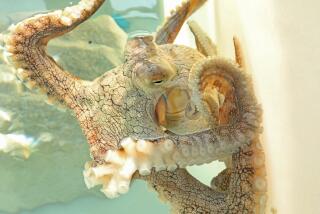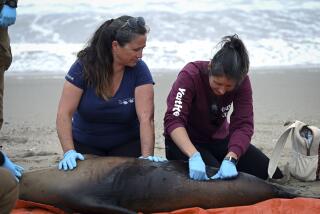Officials partly lift advisory on California’s rock and Dungeness crab

It’s been a sad holiday season for lovers of California’s rock and Dungeness crabs. High levels of a toxic alga that could poison humans were detected offshore, prompting state health officials to take the crustaceans off the menu.
But just in time for New Year’s Day, officials partly lifted the advisory Thursday, saying Californians can now safely eat crabs caught along the coasts of Santa Barbara and San Luis Obispo counties.
The warning, however, remains in place for crabs caught in waters north of those counties and all the way to the Oregon border.
In early November, the California Department of Public Health warned that unsafe levels of domoic acid, a toxin, in ocean waters meant that crabs caught north of Ventura County were unsafe to eat.
Domoic acid is a neurotoxin and a natural byproduct of an alga known as Pseudo-nitzschia. Though the neurotoxin can accumulate in shellfish, it does not harm the creatures.
In humans, however, exposure to domoic acid can cause nausea, diarrhea and dizziness. At higher levels, it can lead to seizures and, in rare cases, death.
See more of our top stories on Facebook >>
Though the alga itself isn’t unusual, the massive bloom that produced neurotoxin levels exceeding state limits is. Officials said the size of the algal bloom was probably caused by warmer water temperatures due to El Niño.
But recent tests show that the toxin levels have dropped in southern parts of the state, California Department of Public Health Director Dr. Karen Smith said Thursday.

Still, she cautioned that people should not eat crabs’ viscera, or internal organs. Known as “butter” or “guts,” the viscera typically have higher levels of domoic acid than the body meat, she said.
Smith advised that people remove the viscera and rinse out the body cavity before cooking. She also warned to discard the cooking liquid if boiling or steaming the crab whole.
The California Department of Fish and Wildlife announced Thursday that recreational rock and Dungeness crab fisheries and commercial rock crab fisheries can reopen in Santa Barbara and San Luis Obispo counties.
NEWSLETTER: Get the day’s top headlines from Times Editor Davan Maharaj >>
The rock crab season, which traditionally runs all year, had been halted. The Dungeness crab season, which usually starts in mid-November, didn’t begin.
Fisheries north of the cutoff point of Piedras Blancas Light Station — in San Simeon, in the northern part of San Luis Obispo County — must remain closed, officials said.
Symptoms of domoic acid poisoning occur within 24 hours of consuming the contaminated seafood. No illnesses associated with the neurotoxin were reported in 2015, state health officials said.
soumya.karlamangla@latimes.com
Twitter: @skarlamangla
ALSO
Transforming the end of the 2 Freeway could be the beginning of a new L.A.
2-car crash in Ontario kills 5, including a 6-year-old boy
Advocates push for the U.S. Postal Service to offer basic banking
More to Read
Sign up for Essential California
The most important California stories and recommendations in your inbox every morning.
You may occasionally receive promotional content from the Los Angeles Times.











